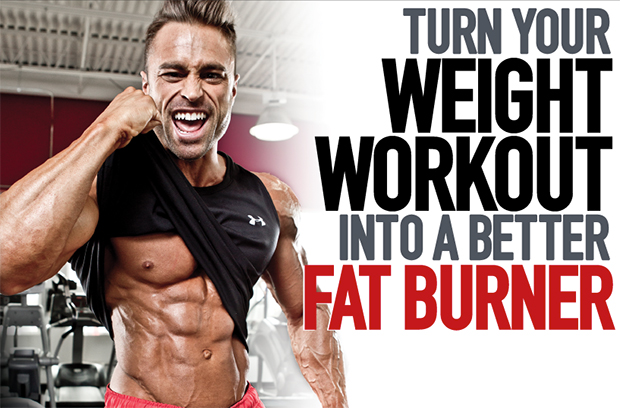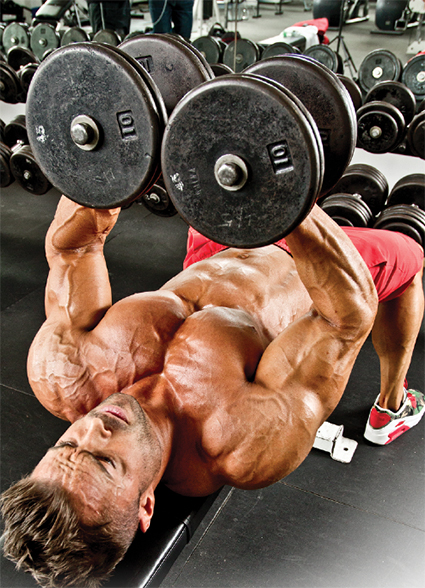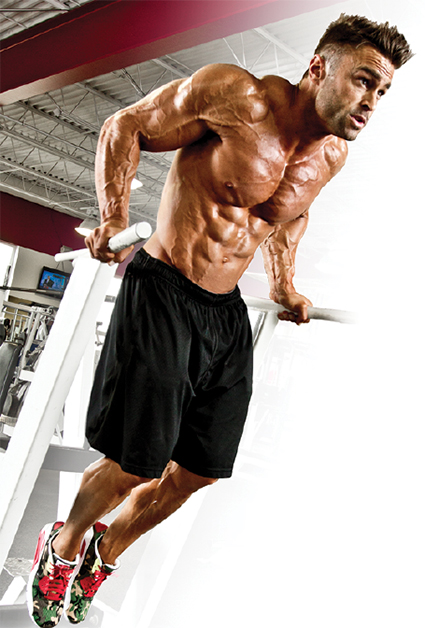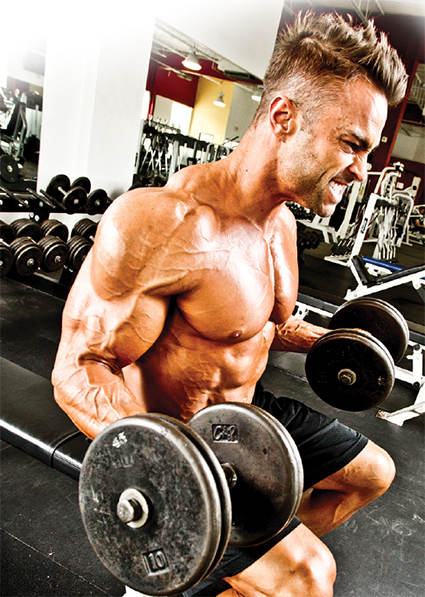Turn Your Weight Workout into a Better Fat Burner

6 Keys To Goosing Your Metabolism With Weights, and A Sample Leg Workout To Show You How To Pull It All Together.
Many of us have dreams of getting big andripped, not unlike many of the fitness models whose physiques grace the pages of MUSCLE INSIDER. What complicates matters is that the workout ideally designed to build muscle isn’t the same one you’d use to maximally target body fat stores. That’s because it’s nearly impossible to chase two goals at the gym simultaneously: You won’t maximize size if you’re trying to lose weight, and you’ll be less successful getting lean if you’re also trying to build muscle size.
If you want to maximize fat burning, it seems, you’ll have to make some adjustments in how you approach your weight workout.
But misinformation also compounds the problem. Just this morning, a certified personal trainer confirmed to me that the best way to burn fat is by lightening your working weights. More reps, he told me, means more work and more calories burned.
That seemingly makes sense, but I’m going to tell you why it doesn’t work the most effectively. Lots of folks run aground in their misguided efforts to get leaner, and that can just leave you smaller and weaker without significant reductions in body fat.
A better approach? Follow these six tips to fine-tune your training to make your gym time far superior at blasting fat and transforming your physique. To put the principles into action, we’ll also provide a sample leg-day workout, a template you can also use with other body parts.
1. Reassess Your Mind-Set

Chasing two opposing goals simultaneously, as mentioned, means you’ll be far less likely to achieve either one very well. Losing fat and getting ripped require a reduction in calorie intake, for one, while putting on muscle means a caloric surplus.
But here’s a critical point to remember: When your goal is to get ripped, as you get leaner you’ll actually lookbigger, an optical illusion of sorts many bodybuilders understand when preparing for a competition. An athlete who is 200 pounds and cut appears larger (and better!) than another who is 230. So that’s going to be your goal here.
Sure, you’ll lose some strength (and size) as you get leaner, but don’t let that get you mentally sidetracked from your larger goal: You’ll appear more muscular by being more ripped.
2. Build Workouts Around Free-Weight, Multi-Joint Exercises
Multi-joint movements such as squats and deadlifts engage a greater number of muscle groups and are superior to single-joint exercises regardless of your goal in the gym. Multi-joint exercises recruit two or more sets of joints working in tandem (and the muscles that attach to them), thus allowing you to lift far heavier loads by comparison. This raises your metabolism both during andafter your workout, a big factor in burning calories.

Multi-joint movements have also been shown to more effectively trigger the release of favourable anabolic hormones such as testosterone and growth hormone, which help you better maintain muscle and burn fat during a caloric deficit. With free weights, you’re required to use more stabilizer muscles to control the weights, again favourably burning more calories.
3. Push Heavy Loads Early in Your Workout
As my friend the personal trainer suggested, should you reduce your training loads and go for higher reps, thereby doing more work? The fault in this reasoning is that you take your foot off the muscle-building accelerator. Heavier weights trigger mechanical tension, thought to be the strongest factor linked to hypertrophy. That signals the muscle to build or retain muscle mass. With lighter weights done for higher reps, you lose that important stimulus and are far more likely to experience size and strength losses.

What’s more, heavier loads (about 6 reps to failure) have been shown to help raise metabolism higher and for longer periods than using lighter loads.1The mechanism, called excess post-exercise oxygen consumption (EPOC), raises your metabolism for up to 24 hours post-workout. EPOC, by the way, is what makes high-intensity interval cardio training so much more effective than steady-state. You can and do achieve a similar effect with your weight workouts, too. If you use light weights exclusively in your training, the EPOC effect is severely reduced.
4. Increase the “Density” of Your Workouts
I’m probably like most folks, setting my ass atop a bench for a minute or two between sets. Cumulatively, that can be a lot of downtime in your workout. By contrast, you can be doing something during that interval, especially if you choose an activity that doesn’t adversely affect the recovery of the muscle group you’re training. That’s the idea behind density training: You add in work during your between-sets recovery so you don’t have to extend the length of your training session. Who wants to do long workouts when on a calorie-restricted diet?
As noted, you still want to train heavy early on, which does require a more usual approach to your rest interval, so what changes is the construction of your workout from about the halfway point. You do that by introducing additional work segments in lieu of downtime. This increases the so-called density of your workout. Density training pairs your main weighted exercise with a body-weight movement that’s timed, say, for 30 to 45 seconds.

The body-weight exercise should never be working the muscles you’re targeting in your main workout so that it doesn’t interfere with normal clearing of the by-products of exercise metabolism. If you’re training legs, for example, add density training with push-ups. Conversely, when training an upper-body muscle group, use body-weight lunges or squats as your density move.
Notably, this type of training will challenge your stamina and conditioning and be especially difficult at first. But as with muscle tissue that adapts to an overload over time, you can work on improving those over time, too.
5. Add Set-Extending Techniques to Increase Calorie Burning

Besides density, you can add intensity boosters such as drop sets, rest-pause, or supersets as a way of pushing your training past muscle failure, extending a given set past the point you’d normally rack the weight. This burns more calories and contributes to keeping your heart rate elevated, and, like density training, it doesn’t significantly affect the length of your training session. Here’s a brief explanation of some common set-extending techniques:
Supersets simply refer to combining two exercises for a target muscle, such as chest presses and flyes, without resting between each movement. (You can also do supersets for antagonist, or opposing muscle groups, such as biceps and triceps.) You rest only when you finish the last movement in the pairing. You can also link three exercises, called tri-sets, or more (giant sets).
Drop Set refers to a set taken to muscle failure, but instead of ending the set, you immediately reduce the load by 20 to 30 percent so you can continue repping to a second point of muscle failure. Fatigue accumulates quickly, which is why you never want to do drop sets early in your training session. Of note, you can do more than a single drop as part of the set.
Rest-Pause is a technique that allows you to almost double the number of reps you do in a single set. There are many variations, but here’s a version that can help with fat loss: Choose a load equal to about your 12-rep max (12RM) but do just 7 reps. Rack the weight and rest no more than 20 seconds. You quickly resume again in this work/rest pattern until you can no longer complete 7 reps. Here you’ll get a better calorie burn by choosing a multi-joint exercise. I strongly recommend against exercises such as seated overhead dumbbell presses, flat-bench dumbbell presses or squats that require a lot of time and effort to get into and out of the start position.
6. Use a Metabolic Finisher to Ramp Up Fat Burning
You typically aim for a deep muscle pump on your last exercise, typically achieved through higher rep training. Flooding the muscle with fluids at the end of your training session impacts what’s called metabolic stress, another mechanism (in addition to mechanical tension, cited in point 3) linked to hypertrophy. Higher-rep sets work especially well here, but you can amplify the efforts by engaging in techniques such as FST-7 or cluster sets, limiting your rest times between sets.
While you typically save single-joint movements for the end of your workout, in this case a multi-joint exercise can benefit you more. Multi-joint movements engage more muscle mass, which, as we argued previously, increases the number of calories you burn not only during your exercise session but also through EPOC, which is nothing to be sneezed at. Here, however, a machine exercise may be a better choice than free weights because you’re so already highly fatigued. Without having to worry about balancing a weight or losing your balance, you simply have to get in position and push until you can’t go any longer.

FST-7 is a popular method to finish your workouts. Choose a weight you can do for 10-12 reps. You’ll complete 7 sets, each to failure, but you’ll take only an abbreviated 30-second rest interval between sets. If your reps start to fall off, simply reduce the weight. With cluster sets, another finishing technique, you do a movement for time, say three to four minutes. Start with your 12RM weight and do as many reps as you can (most likely 12, at least on the first of the seven sets), then rest for only 15 seconds. Continue this work/rest pattern for the allotted period of time. Reduce the load if necessary because fatigue accumulates quickly with such shortened rest intervals.
While this article focuses on adjustments you can make to your weight workout to turn it into a better fat burner, don’t forget that cardio activity—especially high-intensity interval training (HIIT)—helps you burn more calories in less time. You’ll want to consult a MUSCLE INSIDER article on HIIT training for more details.
_______________________
Reference
1. Børsheim E, Bahr R. Effect of exercise intensity, duration and mode on post-exercise oxygen consumption. Sports Med. 2003;33(14):1037-60.

